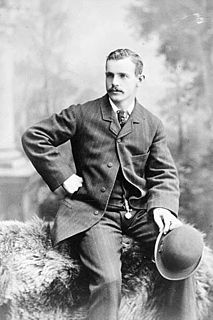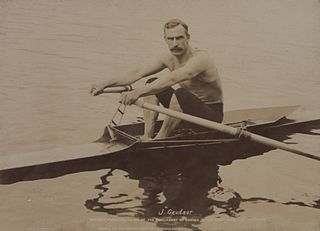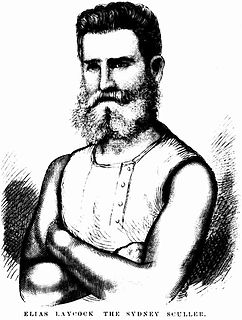
Leander Club, founded in 1818, is one of the oldest rowing clubs in the world, and the oldest non-academic club. It is based in Remenham in Berkshire, England and adjoins Henley-on-Thames. Only three other surviving clubs were founded prior to Leander: Brasenose College Boat Club and Jesus College Boat Club and Westminster School Boat Club, founded in 1813.

Edward "Ned" Hanlan was a professional sculler, hotelier, and alderman from Toronto, Ontario, Canada.

Thames Rowing Club is the joint third-oldest non-academic rowing club on the Thames and is in Putney, London. It was founded in 1860, the same year as Twickenham Rowing Club.

Edward "Ned" Trickett was an Australian rower. He was the first Australian to be recognised as a world champion in any sport, after winning the World Sculling Championship in 1876, a title he held until 1880, when he was beaten by Canadian Ned Hanlan.
Harry Kelley (1832–1914) was a famous professional oarsman on the Thames. He became the Tyne, Thames, English and World Sculling Champion, a title he won four times.

Henry Thomas "Harry" Blackstaffe was a British rower who competed in the 1908 Summer Olympics.

Robert Chambers was a famous Tyneside professional oarsman. He became the Tyne, Thames, English and World Sculling Champion.

Tideway Scullers School is a rowing club on the Tideway of the River Thames next to Chiswick Bridge in Chiswick, London.
The World Sculling Championship (1863–1957), evolved from the Championship of the Thames for professional scullers.

Ernest James Barry was a British rower and Thames Waterman, five times Sculling World Champion during the early part of the 20th century and winner of the Doggett's Coat and Badge Race in 1903.
Robert Coombes, celebrated professional oarsman and Champion Sculler, was born at Vauxhall, Surrey.

For the Canadian Footballer and Commissioner, see Jake Gaudaur.
Kenneth Victor Dwan is a former British rower who competed in the Olympic Games in 1968 and 1972 and won the Wingfield Sculls six times.
Tom Cole was the Professional Single Sculls World Champion from 1852 to 1854. He resided in Chelsea. At the time, he became the Champion of the Thames which was effectively the Champion of England. After the English title gained the world status in 1876, earlier winners were retrospectively given the World Champion Title.

Thomas Sullivan was a New Zealand amateur rowing and sculling champion who later turned professional and challenged for the World Sculling Championship title. He later became a rowing coach.

Elias Connell Laycock was an Australian competitive rower who three times tried to become the World Sculling Champion.

Michael Rush was an Irish Australian sculler noted for his one-on-one competitions against champion opponents, which drew vast crowds of spectators. He attempted to win the World Sculling Championship.
Charles R. Harding was an English professional single sculler who became the Champion of England and was a contender for the World Sculling Championship. He was born in London circa 1866 and his occupation was that of a waterman. Like many of the professional English scullers, he had won the Doggett's Coat and Badge, but at 5 ft 5 ½ in and 9 st 5 lb he was not regarded as one of the heavy men. He made a name for himself in 1883, when he, at 16 years old, won the Chelsea Coat and Badge, and a year later, the Putney Coat and Badge. He was reported in the mid-1890s that “he pulls a beautiful even stroke, gets well over his sculls, while his leg-work is greatly admired.”
















